剑桥卓乐幼儿英语 第三级 教学参考教案
- 格式:doc
- 大小:112.00 KB
- 文档页数:16
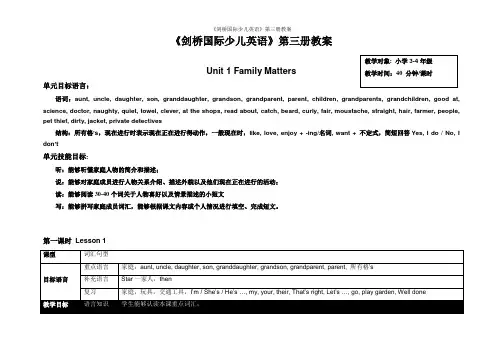
《剑桥国际少儿英语》第三册教案单元目标语言:语词:aunt, uncle, daughter, son, granddaughter, grandson, grandparent, parent, children, grandparents, grandchildren, good at, science, doctor, naughty, quiet, towel, clever, at the shops, read about, catch, beard, curly, fair, moustache, straight, hair, farmer, people, pet thief, dirty, jacket, private detectives结构:所有格’s,现在进行时表示现在正在进行得动作,一般现在时,like, love, enjoy + -ing/名词, want + 不定式,简短回答Yes, I do / No, I don’t单元技能目标:听:能够听懂家庭人物的简介和描述;说:能够对家庭成员进行人物关系介绍、描述外貌以及他们现在正在进行的活动;读:能够阅读30-40个词关于人物喜好以及情景描述的小短文写:能够拼写家庭成员词汇,能够根据课文内容或个人情况进行填空、完成短文。
第一课时Lesson 1课堂教学过程(40 mins)第二课时Lesson 2课堂教学过程(40 mins)课堂教学过程(40 mins)第四课时Lesson 4课堂教学过程(40 mins)第五课时Lesson 5课堂教学过程(40 mins)第六课时Lesson 6第七课时Lesson 7第八课时Lesson 8课堂教学过程(40 mins)《剑桥国际少儿英语》第三册教案。
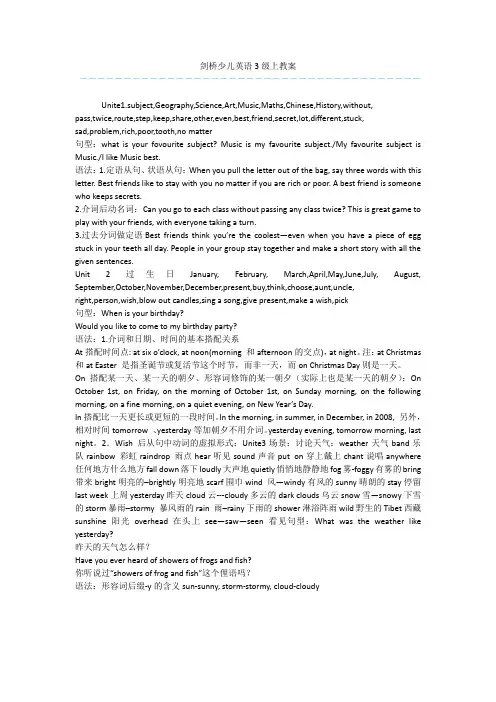
剑桥少儿英语3级上教案---------------------------------------Unite1.subject,Geography,Science,Art,Music,Maths,Chinese,History,without,pass,twice,route,step,keep,share,other,even,best,friend,secret,lot,different,stuck,sad,problem,rich,poor,tooth,no matter句型:what is your fovourite subject? Music is my favourite subject./My favourite subject is Music./I like Music best.语法:1.定语从句、状语从句:When you pull the letter out of the bag, say three words with this letter. Best friends like to stay with you no matter if you are rich or poor. A best friend is someone who keeps secrets.2.介词后动名词:Can you go to each class without passing any class twice? This is great game to play with your friends, with everyone taking a turn.3.过去分词做定语Best friends think you’re the coolest—even when you have a piece of egg stuck in your teeth all day. People in your group stay together and make a short story with all the given sentences.Unit 2 过生日January, February, March,April,May,June,July, August, September,October,November,December,present,buy,think,choose,aunt,uncle,right,person,wish,blow out candles,sing a song,give present,make a wish,pick句型:When is your birthday?Would you like to come to my birthday party?语法:1.介词和日期、时间的基本搭配关系At搭配时间点: at six o’clock, at noon(morning 和afternoon的交点),at night。
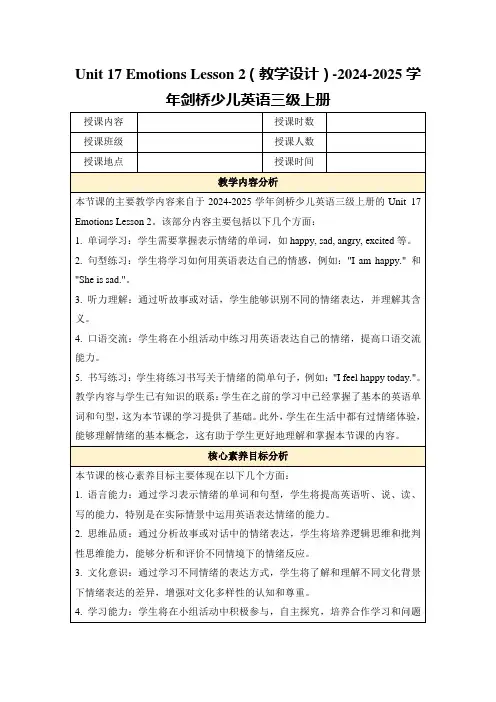
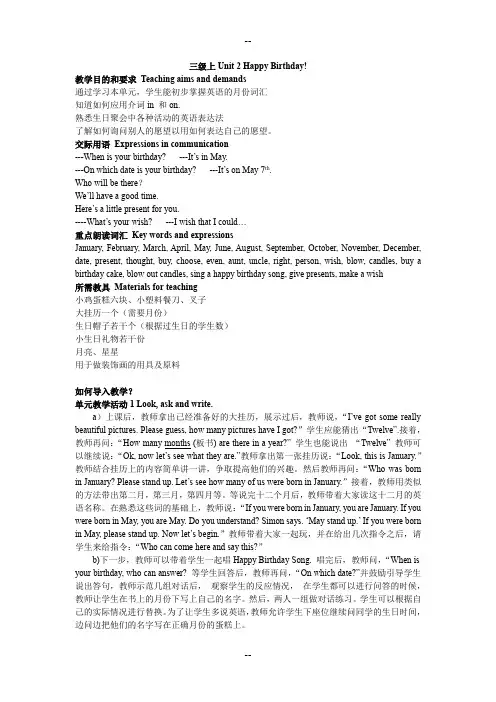
三级上Unit 2 Happy Birthday!教学目的和要求Teaching aims and demands通过学习本单元,学生能初步掌握英语的月份词汇知道如何应用介词in 和on.熟悉生日聚会中各种活动的英语表达法了解如何询问别人的愿望以用如何表达自己的愿望。
交际用语Expressions in communication---When is your birthday? ---It’s in May.---On which date is your birthday? ---It’s on May 7th.Who will be there?We’ll have a good time.Here’s a little present for you.----What’s your wish? ---I wish that I could…重点朗读词汇Key words and expressionsJanuary, February, March, April, May, June, August, September, October, November, December, date, present, thought, buy, choose, even, aunt, uncle, right, person, wish, blow, candles, buy a birthday cake, blow out candles, sing a happy birthday song, give presents, make a wish所需教具Materials for teaching小鸡蛋糕六块、小塑料餐刀、叉子大挂历一个(需要月份)生日帽子若干个(根据过生日的学生数)小生日礼物若干份月亮、星星用于做装饰画的用具及原料如何导入教学?单元教学活动1 Look, ask and write.a)上课后,教师拿出已经准备好的大挂历,展示过后,教师说,“I’ve got some really beautiful pictures. Please guess, how many pictures have I got?”学生应能猜出“Twelve”.接着,教师再问:“How many months (板书) are there in a year?” 学生也能说出“Twelve” 教师可以继续说:“Ok, now let’s see what they are.”教师拿出第一张挂历说:“Look, this is January.”教师结合挂历上的内容简单讲一讲,争取提高他们的兴趣。
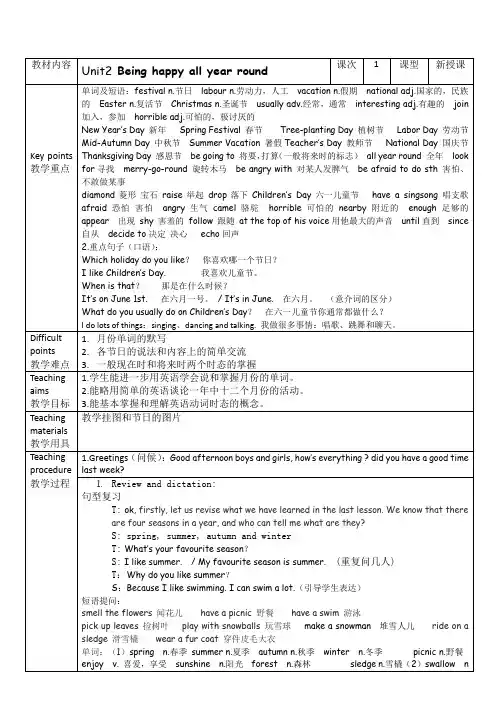
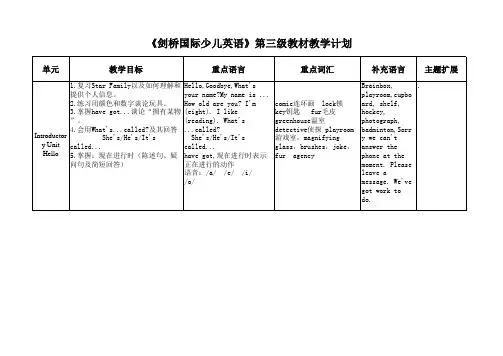
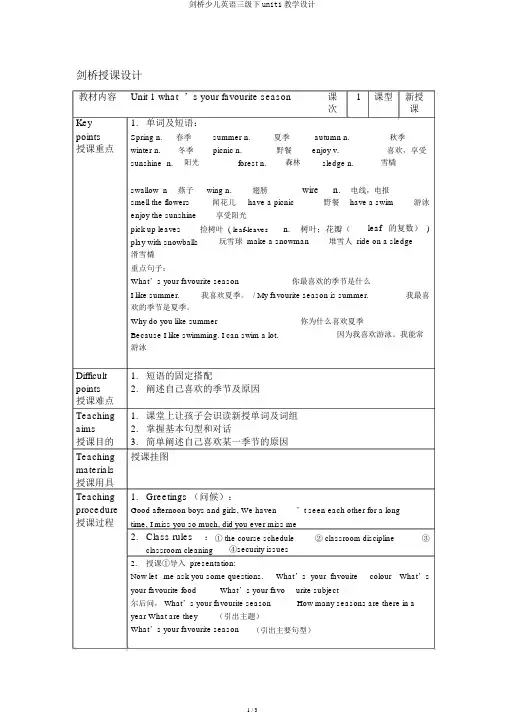
剑桥授课设计教材内容Unit 1 what ’s your favourite season课1课型新授次课Key 1.单词及短语:points Spring n.春季summer n.夏季autumn n.秋季授课重点winter n.冬季picnic n.野餐enjoy v.喜欢,享受sunshine n.阳光forest n.森林sledge n.雪橇swallow n燕子wing n.翅膀wire n.电线,电报smell the flowers闻花儿have a picnic野餐have a swim游泳enjoy the sunshine享受阳光pick up leaves捡树叶 ( leaf-leaves n.树叶;花瓣(leaf 的复数))play with snowballs玩雪球 make a snowman堆雪人 ride on a sledge滑雪橇重点句子:What’s your favourite season你最喜欢的季节是什么I like summer.我喜欢夏季。
/ My favourite season is summer.我最喜欢的季节是夏季。
Why do you like summer你为什么喜欢夏季Because I like swimming. I can swim a lot.因为我喜欢游泳。
我能常游泳Difficult 1.短语的固定搭配points 2.阐述自己喜欢的季节及原因授课难点Teaching 1.课堂上让孩子会识读新授单词及词组aims 2.掌握基本句型和对话授课目的 3.简单阐述自己喜欢某一季节的原因Teaching授课挂图materials授课用具Teaching 1.Greetings (问候):procedure Good afternoon boys and girls, We haven’t seen each other for a long授课过程time, I miss you so much, did you ever miss me2.Class rules:① the course schedule② classroom discipline③classroom cleaning④security issues2.授课①导入 presentation:Now let me ask you some questions.What’s your favouite colour What’syour favourite food What’s your favo urite subject尔后问, What’s your favourite season How many seasons are there in ayear What are they(引出主题)What’s your favourite season(引出主要句型)②操 practice:(1) Spring ——( 2)What’s your favourite seasonSummer——I like summer. / My favourite season is summer.Autumn—— (fall美式英)Winter ——( 3) Why do you like xxx(学生回答)E.g.: I like autumn or My favourite season is autumn,because autumn is a mature season,I can eat all kinds of fruits in this time, suchas apple, orange, and strawberry.Part5 let ’s see What are the two classmates thinking And practice with your partner. ( page 5 )smell the flowers花儿( 4)now let’s look a beautiful picture ,first what can you see in the part③ 出 production:Spring —— picnic,swallow,butterfly,wing—— have a picnic野餐fly a kite放筝This is spring. It is beautiful.It ’s warm. Trees turnbegin to sing in the trees. Look at these children, they are playingoutside ⋯⋯green, birdsSummer—— enjoy ,sunshine—— have a swim游泳enjoy the sunshine享受阳光Autumn—— forest————go to the forestpick up leaves去森林叶pick up起;得;整理Please pick up those books. Where do I pick up the ticket 把些整理好。
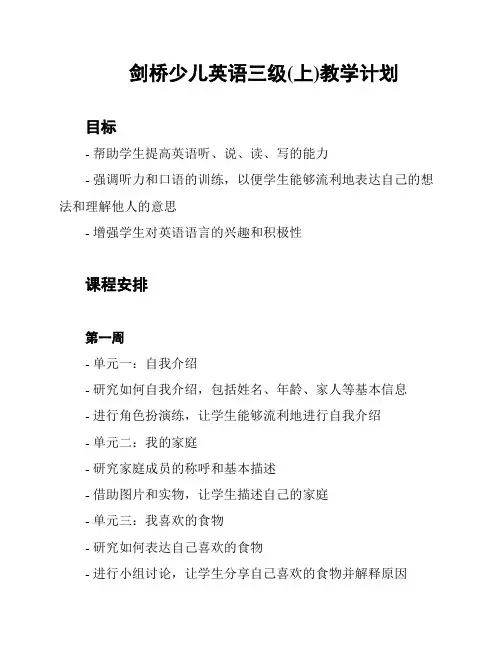
剑桥少儿英语三级(上)教学计划目标- 帮助学生提高英语听、说、读、写的能力- 强调听力和口语的训练,以便学生能够流利地表达自己的想法和理解他人的意思- 增强学生对英语语言的兴趣和积极性课程安排第一周- 单元一:自我介绍- 研究如何自我介绍,包括姓名、年龄、家人等基本信息- 进行角色扮演练,让学生能够流利地进行自我介绍- 单元二:我的家庭- 研究家庭成员的称呼和基本描述- 借助图片和实物,让学生描述自己的家庭- 单元三:我喜欢的食物- 研究如何表达自己喜欢的食物- 进行小组讨论,让学生分享自己喜欢的食物并解释原因第二周- 单元四:我的学校- 研究学校相关的词汇和表达方式- 利用图片和视频,让学生描述自己的学校并进行对话练- 单元五:我的爱好- 研究如何表达自己的爱好和兴趣- 进行小组活动,让学生分享自己的爱好并互相交流- 单元六:动物世界- 研究动物的名称和基本描述- 利用图片和视频,让学生描述自己喜欢的动物并介绍有趣的事实第三周- 单元七:四季变换- 研究四季的名称和特点- 进行诗歌朗读和绘画活动,让学生通过多种方式表达四季的变化- 单元八:我喜欢的节日- 研究各种节日的名称和庆祝方式- 进行小组讨论,让学生分享自己喜欢的节日并解释原因- 单元九:我的梦想- 研究如何表达自己的梦想和目标- 借助图片和故事,让学生描述自己的梦想并鼓励他们追求自己的梦想总结通过以上的教学计划,学生将在听、说、读、写的各个方面得到综合训练。
同时,通过多样化的教学活动,激发学生学习英语的兴趣和积极性。
这份教学计划旨在提高学生的英语能力,并培养他们的自信心和自我表达能力。
希望学生们在这个过程中能够享受学习英语的乐趣,取得进步。
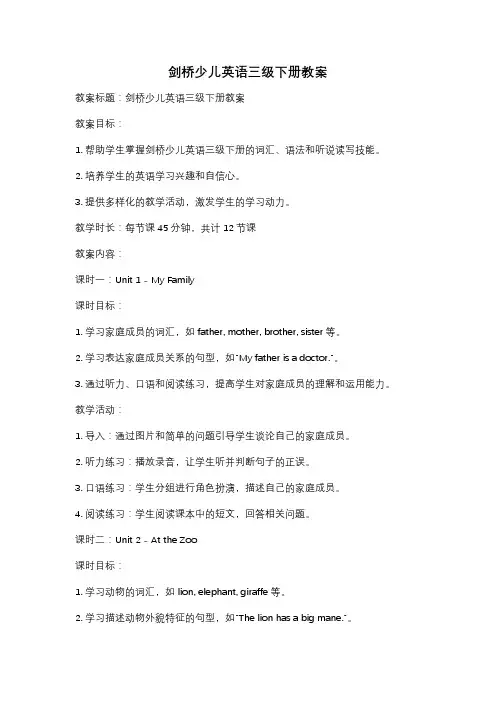
剑桥少儿英语三级下册教案教案标题:剑桥少儿英语三级下册教案教案目标:1. 帮助学生掌握剑桥少儿英语三级下册的词汇、语法和听说读写技能。
2. 培养学生的英语学习兴趣和自信心。
3. 提供多样化的教学活动,激发学生的学习动力。
教学时长:每节课45分钟,共计12节课教案内容:课时一:Unit 1 - My Family课时目标:1. 学习家庭成员的词汇,如father, mother, brother, sister等。
2. 学习表达家庭成员关系的句型,如"My father is a doctor."。
3. 通过听力、口语和阅读练习,提高学生对家庭成员的理解和运用能力。
教学活动:1. 导入:通过图片和简单的问题引导学生谈论自己的家庭成员。
2. 听力练习:播放录音,让学生听并判断句子的正误。
3. 口语练习:学生分组进行角色扮演,描述自己的家庭成员。
4. 阅读练习:学生阅读课本中的短文,回答相关问题。
课时二:Unit 2 - At the Zoo课时目标:1. 学习动物的词汇,如lion, elephant, giraffe等。
2. 学习描述动物外貌特征的句型,如"The lion has a big mane."。
3. 通过听力、口语和写作练习,提高学生对动物的认知和表达能力。
教学活动:1. 导入:通过展示图片和简单的问题,引导学生讨论自己喜欢的动物。
2. 听力练习:播放录音,让学生听并选择正确的动物名称。
3. 口语练习:学生两两合作,互相描述自己选择的动物。
4. 写作练习:学生根据提示,写一篇关于自己喜欢的动物的短文。
课时三:Unit 3 - My School课时目标:1. 学习学校设施和课程的词汇,如classroom, library, math, English等。
2. 学习描述学校设施和课程的句型,如"Our school has a big library."。
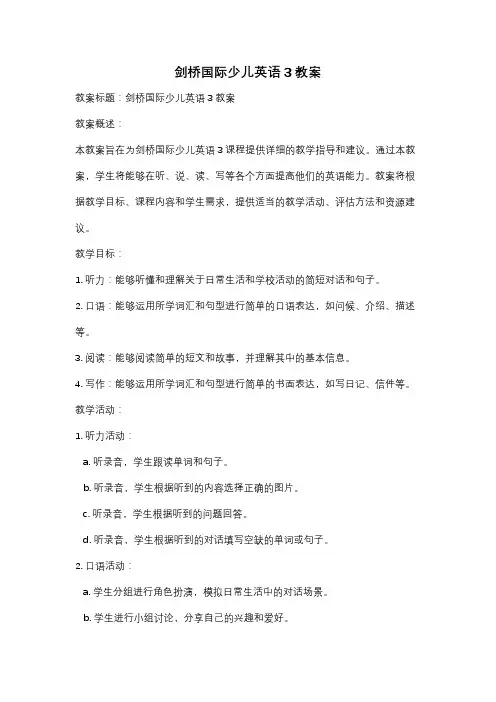
剑桥国际少儿英语3教案教案标题:剑桥国际少儿英语3教案教案概述:本教案旨在为剑桥国际少儿英语3课程提供详细的教学指导和建议。
通过本教案,学生将能够在听、说、读、写等各个方面提高他们的英语能力。
教案将根据教学目标、课程内容和学生需求,提供适当的教学活动、评估方法和资源建议。
教学目标:1. 听力:能够听懂和理解关于日常生活和学校活动的简短对话和句子。
2. 口语:能够运用所学词汇和句型进行简单的口语表达,如问候、介绍、描述等。
3. 阅读:能够阅读简单的短文和故事,并理解其中的基本信息。
4. 写作:能够运用所学词汇和句型进行简单的书面表达,如写日记、信件等。
教学活动:1. 听力活动:a. 听录音,学生跟读单词和句子。
b. 听录音,学生根据听到的内容选择正确的图片。
c. 听录音,学生根据听到的问题回答。
d. 听录音,学生根据听到的对话填写空缺的单词或句子。
2. 口语活动:a. 学生分组进行角色扮演,模拟日常生活中的对话场景。
b. 学生进行小组讨论,分享自己的兴趣和爱好。
c. 学生进行口头描述,描述自己的家庭成员、房间等。
3. 阅读活动:a. 学生阅读简短的短文,回答相关问题。
b. 学生进行小组阅读,共同理解和讨论故事情节。
c. 学生进行阅读理解练习,选择正确的答案。
4. 写作活动:a. 学生写一篇关于自己日常生活的短文。
b. 学生写一封给朋友的信,介绍自己的学校和班级。
c. 学生写一篇关于自己喜欢的动物的描述。
评估方法:1. 听力测试:播放录音,学生根据听到的内容回答问题或选择正确的图片。
2. 口语测试:学生进行角色扮演,模拟日常对话场景。
3. 阅读测试:学生阅读短文,回答相关问题。
4. 写作测试:学生根据题目要求,写一篇短文或信件。
资源建议:1. 教材:剑桥国际少儿英语3教材。
2. 录音材料:包括听力练习和对话录音。
3. 图片和图片卡片:用于听力和口语活动中的选择题。
4. 短文和故事:用于阅读和写作活动。
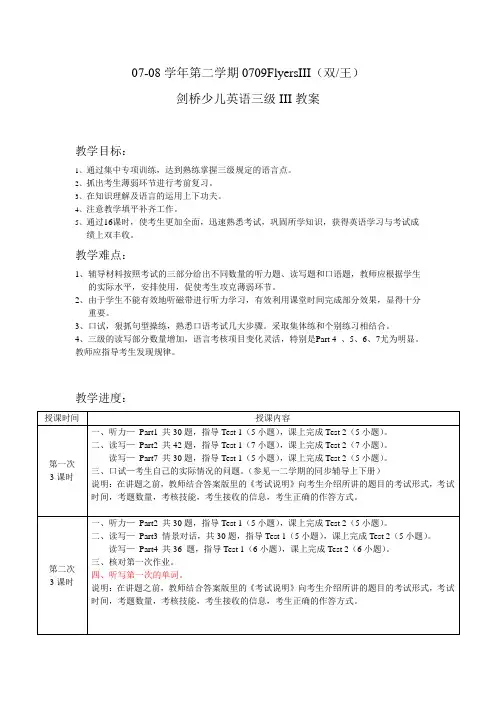
07-08学年第二学期0709FlyersIII(双/王)
剑桥少儿英语三级III教案
教学目标:
1、通过集中专项训练,达到熟练掌握三级规定的语言点。
2、抓出考生薄弱环节进行考前复习。
3、在知识理解及语言的运用上下功夫。
4、注意教学填平补齐工作。
5、通过16课时,使考生更加全面,迅速熟悉考试,巩固所学知识,获得英语学习与考试成
绩上双丰收。
教学难点:
1、辅导材料按照考试的三部分给出不同数量的听力题、读写题和口语题,教师应根据学生
的实际水平,安排使用,促使考生攻克薄弱环节。
2、由于学生不能有效地听磁带进行听力学习,有效利用课堂时间完成部分效果,显得十分
重要。
3、口试,狠抓句型操练,熟悉口语考试几大步骤。
采取集体练和个别练习相结合。
4、三级的读写部分数量增加,语言考核项目变化灵活,特别是Part 4 、
5、
6、7尤为明显。
教师应指导考生发现规律。
教学进度:。
剑桥少儿英语三级教案教案标题:剑桥少儿英语三级——动物世界教案目标:1. 学习并掌握剑桥少儿英语三级课程中有关动物的词汇和句型。
2. 培养学生对动物的兴趣和爱护动物的意识。
3. 提高学生的听说读写能力,培养学生的综合语言运用能力。
教学准备:1. 教材:剑桥少儿英语三级教材2. 多媒体设备:投影仪、音响设备3. 教具:动物图片、卡片、小动物玩具等教学步骤:Step 1: 导入(5分钟)1. 利用多媒体设备播放一段有关动物的视频,激发学生对动物的兴趣,并引导他们回答一些与动物相关的问题。
2. 准备一些动物图片,让学生观察并说出图片上的动物名称。
Step 2: 词汇学习(10分钟)1. 准备一些动物卡片,每张卡片上写有一个动物名称。
让学生分组,每组选择一张卡片,展示给全班,并说出卡片上的动物名称。
2. 教师出示一些动物图片,引导学生说出这些动物的特征和习性,并教授相关的词汇。
Step 3: 句型学习(15分钟)1. 教师出示一些句子模板,例如:“I like _______ because _______.”,让学生根据自己喜欢的动物填写句子,并与同伴分享。
2. 引导学生用所学词汇和句型描述一些动物的外貌、习性等。
Step 4: 听力训练(15分钟)1. 播放教材中与动物有关的听力材料,让学生听并回答问题。
2. 制作一些与动物有关的听力练习题,例如听音选图、听音排序等,让学生进行听力训练。
Step 5: 读写训练(15分钟)1. 学生阅读教材中与动物有关的文章,并回答相关问题。
2. 让学生根据所学词汇和句型,写一篇关于自己喜欢的动物的短文。
Step 6: 温故知新(5分钟)1. 教师与学生一起回顾本节课所学的动物词汇和句型。
2. 学生分组进行问答游戏,巩固所学内容。
Step 7: 作业布置(5分钟)1. 布置课后作业:要求学生找一张自己喜欢的动物图片,并写一段关于这个动物的描述。
2. 鼓励学生多观察自然环境中的动物,积极与动物互动。
Unit1 My Activities第一课时:单词Brush my teeth, comb my hair, do my homework, eat breakfast, get dressed, get up, go to school, go to sleep, play soccer, take the bus, watch TV句型:1)I get dressed.2)She/He goes to bed.听力:P2-Part1.2音标:/e/ breakfast, dressed, get, every day, achead.语法:1.主要学习生活相关的动词短语.2.学习运用单三形式.游戏:短语闪闪卡.PEP:连词成句,并加上标点.1.Ok Are they‘2.help can you I‘3.I can try on them‘4.are just They right‘5.Let’s T size try‘第二课时Unit1 My Activities单词:breakfast, dinner, lunch, after, before, fifteen, forty-five, O’clock thirty, what, what time, who.句型:1)-What time do you get up?-I get up at 7:00.2)-What do you do before/after school?-I comb my hair before/after school.语法:再次学习非整点的时间表达法.听力:P4-part6歌曲:P5-Part8活动:老狼老狼几点钟拓展:再次复习1-60的数字表达及书写.PEP:选出每组中不同的一项.( ) Thanks,How much?( ) Hello, Bob!What would you like?( ) Ten yuan,please.( ) Ok,Here you are.( ) I’d like some beef and rice,please.第三课时:Unit1 My Activities单词:how much, go ahead (one) space, go back (two) spaces句型:-How many friends get dressed before 7:15?-Two.语法:1.再次将前两课所学的重点进行融合复习.2.学习英语阅读理解.听力:阅读文段内容.活动:P10-play the game拓展:自制英语生活作息时间表.PEP:翻译下列句子.1.Here you are2.I’d like some noodles3.I like beef.4.What would you like?第四课时:Unit2 Family Activities单词:aunt, cousin, father, mother, uncle, barber, coach, dentist, doctor firefighter, mail carrier, nurse, pilot, secretary, teacher, waiter句型:1)How many people in your family? Who are they?2)-What does your mother like?-She’s a doctor.语法:1.进一步学习完善家庭成员的称呼.2.再次学习职业的单词及相关句型.音标:/ʌ/ cousin, uncle, cut, mother, hundred听力:P12-Part1活动:角色扮演.PEP:选出每组中不同的一项.( ) 1.A.teacher B.student C.pen( ) 2.A. father B.what C.mother( ) 3.A. where B.who C.family( ) 4.A.play B.brother C.uncle( ) 5.A.mother B.aunt C.ant( )5.Let me clean the blackboard.第五课时:Unit2 Family Activities单词:bring mail, cut hair, do (my) homework, drive a (car), eat (breakfast), Fight fires, fix teeth, fly planes, go for walk, go shopping, go to the movies, help sick people, play (games), serve food, take the bus, teach sports,type letters.句型:-What does your father do?-My father is a teacher. He teaches English.语法:1.再次学习与职业相关的短语.2.学习相关句型.听力:P16-Part7歌曲:P19-Listen(chant)游戏:抢卡片.PEP:选出含有所给音标的选项.( )1. / e/ A.men B.he( )2./ju:/ e( )3./ai / A.bike B.sit( )4./ei / A.bad B.make( )5./ɔ/ A.box B.nose第六课时:Unit2 Family Activities单词:always, never, sometimes, usually句型:She always/never/sometimes/usually goes shopping with her mother.语法:1.学习频率副词及相关句型.频率副词放在系动词后面(am, is, are), 放在行为动词前.2.阅读.拓展:1.often 2.How often do you…….?听力:P16-Part7活动:完成P16-Part8中的练习.PEP:根据提示写单词.1.My (父亲) is a teacher.2.He is (强壮的).3.She is very (和蔼的).4.My (叔叔) is a baseball player.第七课时:Unit3 City and Country单词:building, car, city, movie, theater, museum, skating rink,barn, country, farm, fence, field, grass, house.句型:-Do you like the city or the country?-I love the city!-I love the country!语法:1.了解农村与城市的相关知识2.学习城市与农村的相关单词.游戏:单词联盟大集合.PEP:选词填空.( )1.I have a new . A.near( )2. Is it? B.classroom( )3.It’s the door. C.so( )4.It’s big. D.where第八课时:Unit3 City and Country单词:bird, never, sometimes, usually, duck, fish, horse, sheep, snow, cat, chicken, cow, dog, coat, sandals, cold, hot, small,have/has to句型:1)-What do you have to do every day?-I have to water these plants right now.2) -What does she/he have to do every day?-She/He has to……语法:1.再次学习并复习部分动物的单词.2.学习以have to/has to引导的句型.听力:P25-Part6歌曲:P24-Part5拓展:P26练习题型音标:/æ / cat, sandals, Susan, father, pandaPEP:选择正确的中文翻译.1.Try someA.尝一些B.看一些2.They are tomatoes.A.它们是土豆B.它们是西红柿3.I like carrots.A.我喜欢胡萝卜B.我喜欢兔子第九课时:Unit3 City and Country单词:are, is, clean (my) room, cut the grass, get up, paint the fence go to the supermarket, wash the dishes.句型:1)I usually have to feed the fish.2)There is a mouse in the country.语法:1.在此复习巩固农村城市相关的单词与句型.2.学习阅读理解.活动:角色扮演.PEP:将下列单词按发音规律归类.1.fork2.would3.work4.or5.for6.horse/ɔ://ə/第十课时:Unit4 Animal homes单词:desert, forest, ice, jungle, lake, ocean, plain, river, snow.句型:-Where does parrots live?-They live in the jungle.语法:1.学习大自然的地点名词.2.学习以where引导的相关句型.听力:P32-Part1,2歌曲:P32-Part1活动:摸石头过河.PEP:写出下列单词的复数形式.1.tomato2.hen3.horse .4.goose5.cow6.foot .7.sleep 8baby 9.bus .第十一课时:Unit4 Animal homes单词:camel, chimpanzee, deer, kangaroo, lion, ostrich, parrot,penguin, whale, polar bear, zebra.句型:1)-Do whale live in the forest?-Yes, they do./No, they don’t.2)-Are you a penguin?-Yes, I am./No, I am not.语法:1.进一步学习动物类单词.2.学习一般疑问句的肯否回答听力:P32-Part2歌曲:P35-Part8PEP:按要求填空.1.you(宾格)2.I (宾格)3.her(主格) ‘4.he (宾格)5.my(名词性物主代词) ‘第十二课时:Unit4 Animal homes单词:climb, crawl, fly, jump, run, swim, walk, can, can’t.句型:1)-What can you do?-I can fly.2)-What can/can’t bears do?-They can/can’t……3)-Are you a zebra?-Yes, I’m a zebra.语法:1.学习与动物相关的动词.2.学习以can/can’t相关的句型.听力:P36-Part9PEP:(四上,U2)连线1.钥匙 A. schoolbag2.糖果 B. key3.玩具 C. notebook4.笔记本 D. candy5.书包 E. toy.第十三课时:Unit5 The Weather单词:cloudy, cold, cool, hot, rainy, snowy, sunny, windyfall, spring, summer, fall, winter.句型:-What’s the weather like today?-It’s summer. It’s hot and sunny today.语法:1.学习天气相关的单词.2.学习四季天气变化.听力:P42-Part1,2音标:/i/ cloudy, rainy, snowy, sunny, windy.PEP:(四下,U3)找出与之相对应的反义词.( )1.A.cold A.warm( )2.A. new B.hot( )3.A. tall C.big( )4.A. small D.short( )5.A.cool E.old第十四课时:Unit5 The Weather单词:boots, coat, gloves, hat, jacket, jeans, raincoat, sandalsscarf, shorts, sneakers, sunglasses, sweater, T-shirt, umbrella句型:1)-What do you wear in the winter?-I wear a sweater and a jacket.2)The weather today is rainy, you need an umbrella.语法:1.学习四个季节相关的装饰衣物.2.学习初步的一般过去式(was, yesterday)听力:P44-Part6歌曲:P46-Part9拓展:is – was today – yesterday1. -What’s the weather like today?- It is……2.-What was the weather like yesterday?-It was……PEP:(四下, U3)用所给词的适当形式填空.1.It’s 26 (degree)2.It’s (rain) today.. 3.Let (I) close the window.4.Is it (snow)?5.You can (take off) your shoes.第十五课时:Unit5 The Weather单词:fly a kite, go to the beach, play in the snow, play soccer, skate take away, watch TV.句型:1)-What’s your favorite season?-My favorite season is the fall.2)-What do you do in the spring?-I fly a kite in the spring.语法:1.与季节相关的短语2.学习与季节相关的句型.听力:P47 阅读理解PEP:(四下U3)画出相应的天气符号.1.rainy2.sunny3.cloudy4. windy第一课时:Unit6 The five senses单词:feel, hear,look, see, smell, sound, taste, touchear, eye, finger, nose, tongue.句型:1)We see with our eyes.2)We feel with our fingers.3)We hear with our ears.4)We smell with our nose.5)We taste with our tongue.6)The band sounds great.7)The ice cream tastes sweet.8)The hot dog smells delicious.9)The seals look happy.10)The lamb feels soft.12)The lemonade tastes sour.语法:1.复习器官类单词并学习感官动词.2.学习with引导的句型.听力:P52-53 Part2,4游戏:摸人音标:/ʌ/ touch, tongue, cut.PEP:(四上,U3)选择正确的选项补全对话.A:Hi,John! I have a new friend.B: ?A:Guess. He is tall and . He’s .B:Oh, I know, his name is .A.TimB.a good boyC.Who is heD.thin第二课时:Unit6 The five senses单词:delicious, good, hard, loud, nice, sad, salty, soft, sour,sweet.句型:1)It tastes delicious.2)They look sad.语法:1.学习感官动词对应的形容词.2.学习相关句型.听力:P56-part8游戏:“爱”的初体验PEP:(四上,U3)看音标写单词.1./bɔks/2./rəuz/3./hɔt/4./həum/5./lɔt/6. /nəuz/第三课时:Unit6 The five senses单词:band, candy, candy, flower, drum,clown, hot dog, lamb, lemonade popcorn, seal. .句型:1)Today, they go to the zoo.2)Yesterday, they went to the zoo.3)The band sounds great.语法:再次学习食物类单词.再次使用对比学习一般过去时.听力:P56-part81.直接加ed拓展:动词过去式 2.以辅音加y结尾的动词,改y为i加ed3.不规则变化is - was go - went see - saware - were do - did have - hadcan - could sing - song make - made PEP:(四上,U3)选出每组单词中不属于同一类的一项.( )1.A.thin B.strong C.friend( )2.A. he B.she C.his( )3.A.friend B.boy C.girl( )4.A.green B.blue C.new第四课时:Unit7 The foods I eat单词:butter, candy, cheese, chocolate, cookie, fruit, grape, jam, olives onion, orange juice, pear, pop, strawberry, sugar, toast, tomato, yogurt.句型:-What do you usually have for breakfast?-I usually have a piece of bread for breakfast.语法:1.再次学习食物类单词2.学习与食物相关的句型.听力:P62-part2,part3拓展:名词单数变复数.PEP:(四上,U5)翻译下列句子.1.I’m hungry..2.I’d like some vegetable..3. What would you like for dinner?.4.Dinner’s ready!.第五课时:Unit7 The foods I eat单词:bottle, bowl, box, bunch, can, cup, dish, glass, jar, piece, slice, spoon.句型:-Would you like a piece of bread?-No,thank you.-Yes,please.语法:1.学习量词2.学习以would引导的一般疑问句.(What do you want?=What would you like?)听力:P64-Part5拓展:don’t=do not I’d like=I would likePEP:(四上,U5) 连线.小刀碗筷子叉子勺子chopsticks knife bowl spoon fork第六课时:Unit7 The foods I eat单词:any, some, often, usually, drink, eat, mix, put, wantI’d like, I like/don’t like.句型:1)I usually have a piece of bread for breakfast.2)Put the yogurt in the bowl.语法:1.学习制作食物的相关动词.2.学习以like引导的肯否定句型.拓展:some用于肯定句,any用于否定句.活动:集体一起做水果沙拉.PEP:(四上,U5)翻译下列句子1.Dinner is ready2.Help yourself3.I can use the chopsticks4.Would you like a knife and fork?第七课时:Unit8 Health Habits单词:brush your teeth, exercise, finish, get, get up, go to bed, knock, scare, shout, stay up, take a bath, wash your hair.句型:-What time do you usually get up?-I get up at six o’clock.语法:1.学习生活习惯类的动词短语.2.学习并复习以What time引导的句型.听力:P73-Part3歌曲;P72-Part1拓展:do, don’t, good ,bad, habits.音标:/ai/ right, exercise, tiredPEP:(四下,U2)单项选择( )1.It’s time dinner.A.atB.forC.to( )2.Let’s .A.goesB.goC.going( )3.Time to .A.go to homeB.goes homeC.go home ( )4.What time ?A.it isB.is itC.it’s单词:habit, health, homework, rule, nightgown, salad, sandwich, sleep vegetable, drink/drank, eat/ate.句型:-What did you drink and eat for lunch yesterday?-I eat a cheese sandwich. I drank a glass of juice.语法:1.didn’t=did not2.过去式的运用听力:P75-part7拓展:过去式及单词do - did eat - ate drink - drankPEP:(四下,U5)将下列句子改成一般疑问句,并作肯否回答.1.This is my jacket.2.These are my shoes.3.This is my hat.4.Those are John’s shoes.单词:enough, too much, all the time, every day, downstairs, upstairs, bad good, healthy, sick, tired句型:1)Good habits make you feel good.2)-How do you feel when you don’t get enough sleep?-I feel tired.语法:学习与生活相关的形容词与副词.学习相关句型,How引导的.听力:阅读理解部分.活动:P80 - Play Tic-Tac-talk音标:/w/ what, we, wink, windPEP:(四下,U2)情景交际.( )1.想表达稍等一会,应说:.eB.Just a minute( )2.告诉朋友是时候吃饭了,应该说:.A.Time for dinnerB.Time for bed( )3.询问时间,应说:.A.What time is it?B.What is it?( )4.催促他人快一些,应说:.A.Time to get upB.Hurry up单词:cartoon, comedy, game show, nature show, news, sports,favorite bring, funny, exciting, interesting, scary.句型:1)-What did you watch on TV last night?-Debbie’s New sister2)-What kind of TV show do you like?-I like cartoons because they’re funny.语法:1.学习节目类别的相关形容词.2.学习相关句型.听力:相关类别的视频.活动:调查表.音标:/k/ cartoon, comedy, cake, clean, clean, clock.PEP:(四下,U5) 翻译下列句子1.Put on your shoes..2.Take off your hat..3.Put away your pants..4.Wash your shirk..5.Hang up your dress..第十一课时:Unit9 TV and Movies单词:bed, channel, character, movie, opinion, schedule,story, time, title, type, week.句型:-Why do you like comedy show?-Because it is funny.语法:1.进一步学习与节目相关的名词.2.学习调查提问的常用句型.听力:P85-part7歌曲:P86-part8拓展:type of show.PEP:(四下,U6)按要求写词.1.expensive(反义词)2.big(反义词)3. hot(反义词)4.sock(复数)5.short(反义词)6.to(同音词)第十二课时:Unit9 TV and Movies单词:last night, happen, hurry up, Let’s go, make (my) bed, take (me) out句型:1)-What’s on TV at 10:00?-Captain Invisible. It;s on Channel 3.2)Hurry up, Let’s go.拓展:阅读理解.活动:P90-Moving picture showPEP:(四下,U6)圈出每组中发音相同的字母组合.1.shirt girl hamburger2.mark far park3.talk horse wall第十三课时Unit10单词:play games, building, museum, city, country, bus stop ,do homework, eat breakfast, watch TV, get up, dentist,doctor, nurse, go for walk, go shopping.(U1-U3)句型:1)-What do you do before/after school?-I eat my breakfast.2)-What does your mother do?-She’s a doctor. She helps sick people.3)-What do you have to do today?-I have to clean my room and do my homework.语法:1.he/she/it后面要用动词单三形式.2.复习所学的名词,副词,疑问词.3.练习掌握以What|开头的特殊疑问句用法.拓展:语法知识点加总结与概括.听力:U1-U3PEP:(四下,U6)连词成句.1.is yuan ten It2.help can you I3.very is It pretty4.I it take will第十四课时:Unit10单词:lion, elephant, penguin, dolphin, sun, moon, stars, wind, cloud rain, snow,storm, onion, candy, drum, flower, lemon, hot dog, popcorn.句型:1)-Where do parrot live?-Jungle.2)-What’s the weather like today?-It is/was sunny.3)we see with our eyes.语法:1.对U4-U6的知识做个总结.2初次渗入一般过去式.3.can与can’t的用法.听力:U4-U6PEP:(四下,Recycle2)选词填空mine eleven coat sheep1.Put on your .2.I can see five .3.There are horses .4.It’s .第十五课时:Unit10单词:broccoli, watermelon, sausage, grape, strawberry, olive, movie ticket Video cassette, boring, exciting, funny, interesting, scary.句型:1)-Would you like......?-Yes, please./No, thank you.2)-What time do you usually get up?-At six o’clock.3)-What kinds of TV shows do you like?-I like cartoon.语法:1.don't=do not I’d=I would2.some与any的问法.3.祈使句后面用动词原形.听力:U7-U9PEP:(四下, Recycle2) 选出类别不同的单词.( )1.A.monkey B.great C.fat( )2.A.warm B.wear C.cold( )3.A.twenty B.twelve C.twins ( )4.A. close B.window C.open。
No.1Unit 1 What was the weather like yesterday? Teaching aims and demands●通过学习进一步学习有关天气的词汇●通过简单的英语来描述天气●学会用过去时来询问过去的天气Communication sentencesWhat was the weather like yesterday?It was windy. It’s always hot.Last winter the north was cold, and the east windy.Wordshumid, foggy, dry, drizzling, thundering, clear, mild, warm, England, India, London, Australia, Paris, Greece, Italy, north, south, east, west hot, granny, young pioneer, weather report, dailyTeaching toolsFlash cards:Weather cardsTeaching Procedures新课1H1.Warm up (5min) Warm up教师拿一些已学过的天气的卡片让学生猜,(sunny, windy, ▼rainy, snowy, cloudy) 并加拼写。
2. Ask and answer. (25min)Teacher asks the students: “What’s the weather Presentationl ike today?” It’s sunny. (教师可展示卡片) Then theteacher shows the new cards: foggy, thundering, Part 1humid, clear, dry. What was the weather like ▼yesterday? It was snowy. (教师可引导学生进行回答)3. Activities (15min)1) Students ask and answer in pairs. Practice2) Part 2, Listen to the dialogue and ask somequestions: Part 2Where are you from?What was the weather like in England last winter?Is it always hot in India? Ex.1Was it hot last winter? ▼Now open the books, let’s read this dialogue in pairs.3) Do Ex.1.4. 将本节课内容做总结性的复习 (5min) Closure复习课1H1. Let’s competition. (5min) Warm up两组比赛,写关于weather 的单词。
剑桥少儿英语三级教案设计
剑桥少儿英语三级教案设计
Unite3
场景:讨论天气
单词:
weather天气band乐队rainbow彩虹raindrop雨点
hear听见sound声音puton穿上戴上chant说唱
anywhere任何地方什么地方falldown落下loudly大声地
quietly悄悄地静静地fog雾-foggy有雾的bring带来
bright明亮的–brightly明亮地scarf围巾wind风—windy有风的.
sunny晴朗的stay停留lastweek上周yesterday昨天cloud云---cloudy多云的
darkclouds乌云snow雪—snowy下雪的storm暴雨–stormy 暴风雨的
rain雨–rainy下雨的shower淋浴阵雨wild野生的Tibet西藏
sunshine阳光overhead在头上see—saw—seen看见
句型:
What was th eweathe rlike yesterday?昨天的天气怎么样?
Have you ever heard of shower soffrogsandfish?你听说过“showersoffrogandfish”这个俚语吗?
语法:形容词后缀-y的含义sun-sunny,storm-stormy,cloud-cloudy。
卓乐幼儿英语第三级教案Unit 1 Who are you(teaching aims and demands)1. 鼓励小朋友之间大胆交流,养成说英语的习惯。
2. 在快乐的游戏中习得英语,培养一定的主动交际能力.3. 学会用“who are you”询问对方的姓名,并且能正确回答别人询问自己的姓名的问句Part 1 Let’s play教学内容句型:who are you?I am…教学用具教学主图一幅。
小猫小狗手偶各一个个。
小鸭,小熊,小兔,小猫的小动物面具各一个。
教学活动1.教师走进教室,亲切、和蔼、大声地用英语向小朋友问好:“Hello!”“Nice to meet you ,boys and girls一边问候一边与小朋友挥手。
小朋友回应“Hello,nice to meet you,too”,教师应当高兴地表示赞许,并且引导小朋友表扬自己“Good,good,very good”2.教师拿出手偶,一只手戴一种手偶,模仿小猫的声音对小狗说:“Hello!”“who are you ?”小狗汪汪叫两声后回答,“I am dog,I am dog.”将小狗的手偶让小朋友戴上,老师和其他小朋友一起问“Who are you ?”戴手偶的小朋友回答“I am dog”,看哪位小朋友问的好,就将手偶传给谁。
反复练习。
3.老师请四位表现好的小朋友到前面来,将小狗小猫小鸭小兔的动物面具发给他们戴上,让小朋友围成一个圈,四位小朋友站到圈里去,小朋友一边转圈一边问“Who are you ?”老师说stop,哪只动物没蹲下来,哪只动物就必须马上回答“I am…教学延伸1.教师提示幼儿,用“Who are you ”询问新朋友的名字。
2.建议家长在家播放本课录音,并及时反馈幼儿在家的复习及兴趣状况。
Part 2 chant and sing教学内容Chant: who are youSing: who are you教学用具录音机一台大汽锤一个教学活动1. 教师戴上小狗的手偶,用夸张的表情和变换的语调向幼儿打招呼:“Hello!”问候以后复习上节课内容“who are you ”,先一起问,后面单独问小朋友,加深对句型的掌握。
对反应积极的幼儿及时表扬,引导更多的幼儿回应。
2.复习后,教师配以肢体语言先将chant 表演一遍,再放录音请小朋友一起欣赏。
3教师教唱。
4(打地鼠的游戏)请小朋友围成一个大圆圈,老师拿着一个大气锤,小朋友一唱完,就必须蹲下,没蹲下的小朋友就被大气锤敲下去。
5大家一起练习chant。
6同样方法教唱歌曲。
教学延伸1.教师给幼儿一个家庭作业,让幼儿回家去把所学的chant 和song 唱給爸爸妈妈听。
2请家长给小朋友放录音。
Part 3 exercise教学内容练习:listen and tick; colour it教学用具水彩笔一盒,教学活动1.请小朋友自己和朋友互相练习对话“Who are you”。
2.大家一起复习chant和song.3.单独请小朋友上来表演,培养他们的表演能力和胆量。
4.放录音,做练习25.老师带着小朋友一起做练习5,辨别和复习颜色。
教学延伸1.请家长在家给小朋友再次放练习的录音,巩固复习。
2. 练习chant 和songPart 4 story教学内容:故事情节The clown and the missing nose1. A clown is getting ready for a show. Suddenly he finds t hat his nose is missing. He can’t find his big red nose. “Where is my big red nose?” He hears many people laugh.2. He looks at the platform and sees his dog is on the stage. To his surprise, the dog is wearing his big red nose. He calls to the dog, “Come back! Come back! Give me my big nose.” But the dog doesn’t listen.3. So the clown gets a bone and goes to the dog. The dog sees the clown and runs away.4. The clown holds the bone in his mouth and feels angry. The dog comes back again. He also has a big bone in his mouth. He wants to give the clown a big bone, too. Everybody laughs and thinks that this is a funny and interesting dog.教学用具:1. 一个夸张的红鼻头。
2. 小丑玩具。
3. 小狗玩具。
4. 两根骨头。
教学活动:(对于故事,小朋友需要掌握的是书本里出现的句型,并且能够表演。
)1.老师先把整个故事的大概先讲一遍,对小朋友说,今天老师要请出可爱的小丑,他要为我们做有趣的表演。
然后拿出小丑玩具,指到小丑的鼻子教读nose,一边读一边变魔法似的拿出一个大大的红色鼻子道具,将小丑的小鼻子换成这个大大的红色鼻子,引出big nose, big red nose.2.让小朋友把眼睛闭起来,将大大的红鼻子藏起来,当小朋友睁开眼睛时问道,小丑说道:“where is my big red nose? I can’t find it .”教读,并且可以延伸至其他单词,如: where is my eye/ear/mouth…..? I can’t find it.3. 老师拿出小狗玩具,玩具的嘴巴里含着刚刚丢失的小丑鼻子,老师学着小狗的叫声“wow , wow, wow”,老师再拿出小丑玩具,对着另一只手的小狗玩具说道:“come back! Give me back my big nose”小朋友学着小丑的声音对小狗说“give me back my big nose !”4. 小丑像变魔术似的,拿出了一块骨头,将骨头与小狗嘴里的鼻子交换了,然后将鼻子带到了自己的脸上,非常高兴的笑了,对着小朋友说:Hello,boys and gilsNow,let the show begin.5.将小丑玩具发给小朋友,请小朋友来扮演,老师拿着小狗玩具配合小朋友。
教学延伸:1.教师提示幼儿回家听本课录音时,一定展示出来,表演给家人看。
2.教师在以后的教学中定期复习。
Unit 2 The beautiful hats(teaching aims and demands)1. 复习前面所学内容,用who are you 再次询问小朋友姓名。
2.让小朋友掌握有关服饰的英语,并且能够熟练运用put on和take off.3.复习前面所学的有关颜色的单词。
Part 1 Let’s play教学内容:句型:what a beautiful hats! Come here, put it onHats on and hats offThis one is for you教学用具:1.不同种类、不同颜色的帽子。
2.一面小鼓。
3.小丑手偶一个。
教学活动:1.复习前面所学句型who are you ?,请小朋友之间互相问候。
2.老师拿出一顶漂亮的帽子给一个小朋友戴上,然后对其他小朋友说道:Look! What beautifuol hats!who want to try it ?想要戴漂亮帽子的小朋友需要说出句型:what beautiful hats3.辅以肢体语言教读what beautiful hats! 教读几遍后,引申至what beautiful shoes, what beautiful socks…….4.请小朋友围成一个圆圈,老师戴着帽子站在中间,小朋友一起说what beautiful hats,老师听哪个小朋友说的好就对他说:come here ,put it on.并且将帽子给他戴上。
接着由这个小朋友来找好朋友,请说的好的小朋友上来继续戴帽子,练习句型come here ,put it on5老师拿出五颜六色的帽子,给每个小朋友都戴上,并且一边戴一边说,hats on ,hats on.然后将小朋友的帽子取下来,教读hats off ,hats off.6.老师再次站到圆圈中间,拿出一面小鼓,将小鼓敲一下,小朋友把帽子戴上,并且必须说出hats on.老师将鼓敲两下,小朋友把帽子取下来,并且说到hats off ,做错的小朋友会被小鼓敲一下,以示小惩。
7小朋友戴着帽子走到自己的位置上,老师拿出小丑手偶对小朋友说,look,the crown dosen’t have a hat ,who can give him a hat ? 请一位小朋友拿出自己的帽子给老师,老师给小丑戴上,教读“This one is for you”,教读几遍以后,请小朋友给小丑戴上不同种类的帽子,并且说出句型“This one is for you”.8.游戏:小朋友之间互相交换戴帽子,练习句型“This one is for you”.教学延伸:小朋友回家后找出家里的帽子,给爸爸妈妈戴上,练习This one is for you和短语“hat on ,hat off”Part 2 exercise教学内容:句型put it on, put them on;take it off,take them off单词cap hat shoes socks jacket教学用具:等大毯子一块,再准备一些帽子、靴子、袜子、手套、夹克。
教学活动:1.老师将大毯子在地上平铺开,上面放上帽子、靴子、眼镜、袜子、手套、夹克等。
小朋友围坐一圈。
2. 老师先给小朋友介绍地毯上有什么东西,对于已经学过的,老师可以以提问的方式引导小朋友自己说出。
“This is a hat. What is that?”通过用这种方式,将cap shoes socks jacket 这些单词进行复习。
可以先由老师提问,接着由小朋友自己提问问对方。
3.游戏:老师指导小朋友拿起自己喜欢的东西,“Take the one you like. If you like the cap, take the cap; if you like the socks, take the socks…当小朋友已经拿好了自己喜欢的东西,老师数one two three,小朋友就将自己喜欢的东西穿上,并且一边穿一边说:put it on ,老师再数onetwo three, 小朋友马上又将穿上的东西脱下,并且说出:take it off.老师在旁边发号口令:put them on 和put them off.最后可以请一位学的特别好的小朋友来当小老师,发号施令,练习:put them on 和put them off.教学延伸:1. 小朋友回家后可以把自己平时穿的衣服拿出来和家长或者自己的布娃娃玩这个游戏。